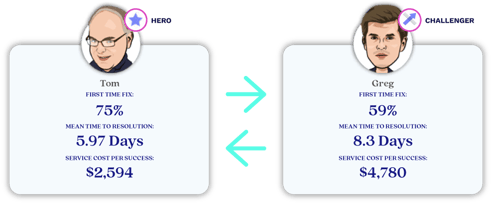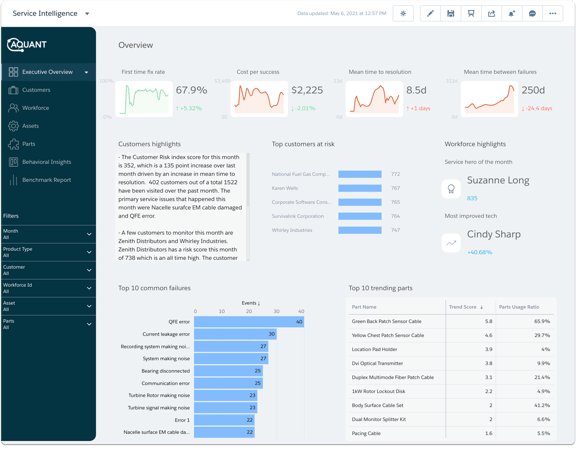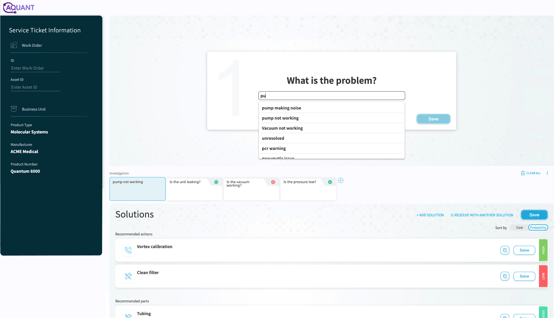In this article, we discuss the findings of Aquant's 2022 Service Intelligence Benchmark Report and look at some key observations about service performance from the customer's perspective.
ARCHIVE FOR THE ‘technology’ CATEGORY
Jan 07, 2022 • Features • Digital Transformation • technology • Aquant • GLOBAL • customer experience
In this article, we discuss the findings of Aquant's 2022 Service Intelligence Benchmark Report and look at some key observations about service performance from the customer's perspective.
The last two years were extremely difficult for the service industry—and not just because of the pandemic. While COVID-19 certainly played a role in exacerbating the issues, workforce labor shortages, complicated equipment, and increasingly reactive service were also challenges faced by many service providers.
And yet, according to the data analyzed in Aquant’s 2022 Service Intelligence Benchmark Report, there is another overarching theme to be found: the way organizations provide service today is not in tune with customer expectations. Six million tickets later, the report reveals some key observations about service performance from the customer’s perspective.
Our report measures data across:
- 76 organizations, including service divisions within OEMs and third-party service organizations across manufacturing, medical devices, capital equipment, HVAC, commercial appliances, and more
- More than 6 million work orders
- More than 31,000 technicians
- $7 billion total in service costs
- An average of 3 years of service data per company
We analyzed:
- How service organizations and their workforce measure up against industry benchmarks
- Why hitting your KPIs rarely equates to outstanding customer experiences
- Why a missed First Time Fix (FTF) event leads to a spiraling negative impact
- How a workforce shortage has exacerbated the existing skills gap between the heroes (highest performers) and challengers (lowest performers) within each organization
Here's what we discovered:
- Service organizations suffer from a wide customer experience (CX) gap. First Time Fix (FTF) rates are one of the biggest contributors to CX gaps, or the difference between what customers expect and what your organization delivers. Our analysis shows that companies who measure FTF rates in 7-day or 14-day windows have artificially inflated FTF rates, and are setting the stage for a wide experience gap. That's the perfect setup for frustrating customer experiences. The moral of the story: a few metrics can’t provide the entire picture—and it’s time to look at experience as a whole.
- The knowledge gap between heroes and challenges is becoming more expensive. In 2021, service organizations faced even larger hiring challenges than in the past. This has left the industry with tens of thousands of unfilled jobs, and caused service costs to increase.
- The bottom quarter of the workforce costs organizations 84% more than the top quarter. That’s 4% higher than last year.
- The top 20% of the workforce (service heroes) has a 75% FTF rate.
- The bottom 20% of the workforce (service challengers) has a FTF rate of 59%.

- It’s possible to overcome these challenges. Your data tells a bigger story—if you know what to look for. Looking beyond your KPIs will help you tailor service for every customer, provide a better CX, upskill your team, and cut costs.
It’s time to understand your business on a much deeper level than ever before. Download Aquant’s 2022 Benchmark Report to see how you stack up to your peers, uncover the stories that your KPI averages are telling, and start seeing your service from the customer’s perspective.
Further Reading:
- Read more about Digital Transformation @ www.fieldservicenews.com/digital-transformation
- Read more about Aquant on Field Service News @ www.fieldservicenews.com/aquant
- Download Aquant's 2022 Benchmark Report @ www.aquant.io/resources/benchmark-report/
- Find out more about Aquant @ www.aquant.io
- Follow Aquant on Twitter @ twitter.com/Aquant_io
- Follow Aquant on LinkedIn @ www.linkedin.com/aquant.io
Nov 04, 2021 • Features • Digital Transformation • technology • Aquant • GLOBAL
In this article from Aquant, we look at three tips to secure approval for new service projects and how to make the right decision for your organisation.
In this article from Aquant, we look at three tips to secure approval for new service projects and how to make the right decision for your organisation.
How to Make the Right Decision For Your Organisation
Artificial intelligence is becoming an essential tool for the service sector — aiding in everything from service delivery and customer support, to employee training.
With nearly 50% of companies reporting that they’ve adopted AI in at least one business function, trends indicate that tech-forward companies are past figuring out if they should lean on AI’s capabilities. Instead, they’re figuring out when they’ll make the investment and how they will implement it.
As companies weigh the pros and cons of adoption, an even bigger question arises: is it better to build a solution in-house or buy it from a vendor?
Ultimately, the questions you should consider are:
· Which option delivers maximum organizational benefit?
· What is the difference in deployment time for building vs. buying?
· How much will it cost to build vs. buy?
· What internal resources or additional consultants will be needed for each option?
· If a quick-to-implement solution fits your organization’s needs, will it offer better ROI in comparison to building a perfect, custom solution that may take twice as much time and resources?
It’s about what offers the biggest benefit to your organization. Here are a few expert tips for figuring out which path is the best fit.
Building an AI Solution
Pros:
● Customization: You can reduce overhead costs by building a solution that’s just right for your company, skipping any unnecessary features.Buying an AI Solution
Pros:
● Cost Effective: AI vendors are the experts. They already have a dedicated/established team and the knowledge needed to pull off a huge launch — no outsourcing necessary.I've made a decision. What's next?
Once you’ve made your choice in the age-old buy-or-build debate, the next step is to get your stakeholders on board. Luckily, we wrote the blueprint for success.
Check out our latest eBook, How to Secure Buy-In for Service Transformation Projects, for expert recommendations on getting even the most skeptical executives to see your AI vision.
Further Reading:
- Read more about Digital Transformation @ www.fieldservicenews.com/digital-transformation
- Read more about Aquant on Field Service News @ www.fieldservicenews.com/aquant
- Learn more about AI on Field Service News @ www.fieldservicenews.com/artificial-intelligence
- Find out more about Aquant @ www.aquant.io
- Follow Aquant on Twitter @ twitter.com/Aquant_io
- Follow Aquant on LinkedIn @ www.linkedin.com/aquant.io
Oct 07, 2021 • News • Artificial intelligence • Digital Transformation • technology • Aquant • GLOBAL
Aquant, the leading Service Intelligence Platform that gives service leaders, reps and teams the most vital information they need for every situation, has raised $70 million in Series C funding. The investment will support the growth and advance its...
Aquant, the leading Service Intelligence Platform that gives service leaders, reps and teams the most vital information they need for every situation, has raised $70 million in Series C funding. The investment will support the growth and advance its industry-leading service intelligence technology.
The funding round was led by Qumra Capital, Insight Partners and Pitango Growth. Previous investors Lightspeed Venture Partners and Angular Ventures also participated in the round, along with new investors Schneider Electric Ventures and Claltech.
Aquant has now raised a total of $110 million. The company will use the fresh capital to support its rapid growth and expand use cases as it strengthens its position as the service intelligence leader in every market for every company that provides service. To accelerate its global expansion, Aquant will grow its engineering, client services and go-to-market teams, adding positions in the US, Europe and Israel. The funding will also drive the continuous innovation of its Artificial Intelligence platform, including the development of cutting-edge technology that combines structured and unstructured data and harnesses the tribal knowledge of experts.
AQUANT'S RAPID GROWTH IS A DIRECT RESULT OF HOW IT'S HELPING COMPANIES OF ALL SIZES MAKE THESE TRANSFORMATIVE CHANGES.
“To win the service game today, it’s not enough to just solve problems anymore,” said Shahar Chen, CEO and co-founder of Aquant. "Companies must also provide a stellar service experience. And when providing a stellar experience, service becomes more than just 'maintenance' for customers – it becomes magic.” Using deep service expertise and specialized Natural Language Processing (NLP), Aquant understands all service data, combines it with tribal knowledge, and provides service leaders, technicians, and reps with the most vital information they need, exactly when they need it. Service has largely remained the same for decades, but is now at a turning point. Companies are seeking to transform the way they deliver service, with service leaders expected to deliver exceptional service to differentiate the brand. They are also being asked to provide customer insights, derived from service data, to help executives and front line managers make strategic business decisions across all lines of business, including service, product development, sales, and more.
Aquant’s rapid growth is a direct result of how it’s helping companies of all sizes make these transformative changes. The company gives service leaders needed insights into their business, enabling them to make proactive, data-driven decisions, identify at-risk customers, understand asset performance, identify compliance risks, and more. The AI-powered technology is also helping to erase the talent shortage by providing the entire workforce access to information that was previously siloed in databases or held in the minds of long-tenured technicians.
Leading market researchers like Gartner Research have noted the unfulfilled need to leverage service intelligence throughout the industry, citing the powerful potential of machine learning and data mining to increase field service efficiency.
Aquant’s proprietary service intelligence platform harnesses Artificial Intelligence to ingest unstructured data, tribal knowledge, and industry insights. This combination gives service leaders meaningful insights into the state of their organization, enabling them to make data-driven decisions. It also empowers service technicians to be at the right place with the right knowledge and the right parts at the right time to solve technical problems immediately. Making every Aquant-powered customer experience a magical service interaction.
“Aquant is revolutionizing service intelligence and is well-positioned to lead this large market given their domain expertise and data savviness. Their technology enables companies to focus on what they’re good at, alleviating one of the most serious business challenges today,” said Sivan Shamri Dahan, managing partner at Qumra Capital. “We’re very excited to partner with them as they continue their rapid growth in order to significantly improve service experiences.”
Service intelligence solves an increasingly problematic talent shortage in the field service industry, providing new hires access to decades of technical knowledge, account data and service history at their fingertips. As Baby Boomers continue to retire from technician roles and younger Millennial and Generation Z employees fill their positions, sharing knowledge and employing data effectively will be increasingly important.
“Customers trust Aquant’s AI-enabled offering, as unlike generic AI solutions, it is tailored to the service vertical’s needs and delivers clear ROI from day one,” said Idit Muallem-Yedid, partner at Pitango Growth, who's joining Aquant's Board. “Aquant's insights shed light on areas traditionally perceived as blind spots in service operations and experience. I am excited to be part of Aquant’s journey, as it continues to bring value to all stakeholders of the service experience and roll out additional solutions highly anticipated by its customers.”
"We look forward to working with our new investors as we enter an important growth phase," said Assaf Melochna, president and co-founder of Aquant. "The service industry is on the cusp of once-in-a-lifetime advancements, and helping these companies transform service by providing critical business insights is built into Aquant's DNA." The company works across a number of industries, including medical device manufacturers, food equipment manufacturers, capital equipment manufacturers, industrial automation and appliances. Its clients include Siemens Healthineers, The Home Depot, 3D Systems, and Sysmex, among others.
Further Reading:
- Read more about Digital Transformation @ www.fieldservicenews.com/aquant
- Read more about Aquant on Field Service News @ www.fieldservicenews.com/aquant
- Read more about Artificial Inteeligence @ www.fieldservicenews.com/artificial-intelligence
- Learn more about Aquant @ www.aquant.io
- Follow Aquant on Twitter @ twitter.com/Aquant_io
Jul 13, 2021 • Features • Artificial intelligence • Digital Transformation • technology • Aquant • GLOBAL
The platform converts messy service data into detailed insights for service executives, providing visibility into customers at risk of churn and workforce training opportunities.
The platform converts messy service data into detailed insights for service executives, providing visibility into customers at risk of churn and workforce training opportunities.
Service executives, do you want to see into the future and prevent customer disasters ahead of a negative Net Promoter Score (NPS) or service escalation? Aquant’s Service Insights makes that possible by doing all the complex data analysis for you.
“Historically, service decisions have been made using only a fraction of available service data. That causes blind spots into customer satisfaction and creates an environment of reactive problem-solving. If you wait until you receive a negative NPS, it’s too late,” says Shahar Chen, CEO and co-founder, Aquant. “The new normal in service requires providers to approach customers with solutions before a customer comes to a provider with a complaint.”
That kind of data-driven decision-making fosters better customer experiences and improves service outcomes. But before you can make informed decisions, you need a clear picture of what story the data is telling — and that’s been a roadblock for many organizations.Service Insights Curates and Analyzes Disparate Data and Provides Actionable Recommendations

“We’ve worked with leading service organizations to build a powerful analytics tool that is designed for business users,” adds Assaf Melochna, president and co-founder, Aquant. “Service Insights provides targeted information in the language that service leaders understand, and it does so in days, without the need for a multi-department deployment.”
Service Insights is Not a BI Tool. It’s an Entire Data Science Team at Your Fingertips
Aquant delivers a 360-degree view of the service lifecycle. Unlike traditional BI tools, Service Insights is able to access more of your data, and then analyze and interpret it — without the need for a team of data scientists. Users will see immediate value following a simple deployment process. Isolated data points become descriptive and predictive intelligence presented through auto-generated reports and easy-to-access graphical dashboards. Here’s what’s possible with Service Insights:
- Mine insights out of your (un)structured service data - Gain a deeper dimension of insight into your unstructured data with Aquant’s Service Intelligence Engine by identifying key symptom and solution data directly from customer comments, call center agent notes, field technician debriefs, and machine log files. Formerly hidden data becomes a powerful decision-making tool.
- Generate service performance and risk models - Service Insights automatically generates trends, recommendations, industry benchmarks, and predictions based on more than 5 million service tickets from manufacturers and service providers. Leverage Aquant’s predictive modeling to create customer risk scorecards, and manage workforce performance, and training strategies.
- Get the right insight at the right time - Need a quick summary of your business, a snapshot of customers, or an overview of the workforce before your next meeting? Aquant auto-generates easy-to-read overviews for each customer or service provider, identifying key statistics and important trends. Focus on the most critical service issues without having to dig into dashboards.
To learn more or schedule a demo, get in touch.
Further Reading:
- Read more about Digital Transformation @ www.fieldservicenews.com/aquant
- Read more about Aquant on Field Service News @ www.fieldservicenews.com/aquant
- Find out more about Aquant's AI Tool Service Insights @ www.aquant.io/platform/service-insights/
- Learn more about Aquant @ www.aquant.io
- Follow Aquant on Twitter @ twitter.com/Aquant_io
Jul 12, 2021 • Features • service excellence • technology • Aquant • Covid-19 • Leadership and Strategy • GLOBAL
In this article from Aquant, we look at three tips to scale appliance and food repair businesses rapidly with the help of easy-to-use AI tools.
In this article from Aquant, we look at three tips to scale appliance and food repair businesses rapidly with the help of easy-to-use AI tools.
Service businesses are busy in 2021, and all indicators point to steady — or even above-average demand — lasting for the foreseeable future. Typically, high demand is great for business, but nothing has been typical about service in the last year. Many companies, especially owner-operator repair businesses, are turning away customers and additional revenue because they’re at capacity.
What Challenges Do Service Companies Face?
While industry demand has outstripped technician supply for at least the last decade, most businesses were able to manage — but COVID exacerbated the challenges of a sector already pushed to its limits. Some of the biggest contributing factors include:
● A lack of qualified appliance repair techniciansService businesses, from home appliance to food equipment repair and maintenance, are experiencing such a high volume of service requests that the search for qualified technicians has reached a tipping point.
“Repair companies are triaging calls, hiring new employees and navigating backlogs from the broken supply chain for parts,” states the Washington Post. That was just one account of many from an in-depth article that details the extent of the gap between service provider availability and customer demand across the country.
But rapid hiring, especially when paired with a scarcity of parts, puts added pressure on service providers who are already maxed out. Sound familiar?

What Challenges Do Service Companies Face?
New, easy-to-use AI tools are available to help service companies of all sizes upskill a new crop of employees quickly. This ultimately makes it possible for your business to take on extra demand while still providing exceptional customer experiences.
1. Upskill the New Workforce Quickly to Slash the Skills Gap
The workforce shortage is not new. Skilled trade positions, particularly technician and engineer roles, have been the hardest to fill. There are other obstacles compounding the issues, too.
The Baby Boomer retirement wave is in full swing. Your most senior techs are leaving and taking all their repair knowledge with them.
Millennials and Gen Z employees approach work differently. The two youngest generations leave jobs nearly twice as often as their older counterparts. This result is an increasing skills gap, and most in the industry don’t have the resources or budget to spend months or years training employees.
A better solution: Hire motivated employees with minimal appliance repair experience and quickly turn them into seasoned experts in weeks instead of years. That’s possible using technology that provides accurate recommendations with as much ease as a Google search.
How Aquant helps: Our service engine has digested and analyzed every major home appliance and food service equipment repair manual, combining them with real-life best practices from veteran, certified technicians. The intelligent tool is easy enough for any member of the workforce to use. That empowers every member of the workforce to perform as well as your longest-tenured employees.
When knowledge is easier to acquire, employees can work on honing soft skills like customer service and relationship building.
3. Offer Clients Remote Resolution Options
How many times have technicians been dispatched to a job site, only to arrive and find that the solution was as simple as hitting the restart button or flipping a switch? Customers don’t want to wait days for a solution that they could have fixed themselves in minutes. And your business can’t maintain wasted truck rolls in the face of a demand avalanche.
A better solution: Train customer support to resolve less complex issues during the initial customer call. Instead of having them flip through manuals or consult decision trees (which takes time and can be frustrating), give them options to triage issues in a matter of minutes using an intelligent, digital tool.
How Aquant can help: We’ve created an intelligent — and evolving — database of service information based on millions of service tickets. Using the smart triage system, your support agent walks through two to four service issue scenarios with the customer, and the tool identifies the most likely solution. If it’s a simple fix, you can guide the customer through remote resolution.
Increase the Number of Brands You Support While Scaling Up
In addition to helping your technicians solve problems faster and more accurately, Aquant is like a cheat sheet for repair and maintenance companies. With data from all the top major home appliance and food service equipment brands, you have access to a pre-populated database with the information any technicians need to get the job done, regardless of the brand.
Further Reading:
- Read more about Aquant on Field Service News @ www.fieldservicenews.com/aquant
- Read more about Service Leadership @ www.fieldservicenews.com/service-leadership
- Learn more about Aquant @ www.aquant.io
- Follow Aquant on Twitter @ twitter.com/Aquant_io
- Follow Aquant on LinkedIn @ www.linkedin.com/aquant.io
Jun 24, 2021 • News • Artificial intelligence • Digital Transformation • technology • Aquant • GLOBAL
Aquant, the leading service intelligence platform announced Service Insights. The tool, capable of analyzing your data out of the box, provides a detailed window into factors that impact customer experiences. This empowers service leaders with the...
Aquant, the leading service intelligence platform announced Service Insights. The tool, capable of analyzing your data out of the box, provides a detailed window into factors that impact customer experiences. This empowers service leaders with the knowledge to prevent customer disasters ahead of a negative Net Promoter Score (NPS) or service escalation.
“Historically, service decisions have been made using only a fraction of available service data. That causes blind spots into customer satisfaction and creates an environment of reactive problem-solving. If you wait until you receive a negative NPS, it’s too late,” says Shahar Chen, CEO and co-founder, Aquant. “The new normal in service requires providers to approach customers with solutions before a customer comes to a provider with a complaint.”That kind of data-driven decision-making fosters better customer experiences and improves service outcomes. But before you can make informed decisions, you need a clear picture of what story the data is telling — and that’s been a roadblock for many organizations.
Service Insights Curates and Analyzes Disparate Data and Provides Actionable Recommendations
“We’ve worked with leading service organizations to build a powerful analytics tool that is designed for business users,” adds Assaf Melochna, president and co-founder, Aquant. “Service Insights provides targeted information in the language that service leaders understand, and it does so in days, without the need for a multi-department deployment.”
Service Insights is Not a BI Tool. It’s an Entire Data Science Team at Your Fingertips
Aquant delivers a 360-degree view of the service lifecycle. Unlike traditional BI tools, Service Insights is able to access more of your data, and then analyze and interpret it — without the need for a team of data scientists. Users will see immediate value following a simple deployment process. Isolated data points become descriptive and predictive intelligence presented through auto-generated reports and easy-to-access graphical dashboards. Here’s what’s possible with Service Insights:
- Mine insights out of your (un)structured service data - Gain a deeper dimension of insight into your unstructured data with Aquant’s Service Intelligence Engine by identifying key symptom and solution data directly from customer comments, call center agent notes, field technician debriefs, and machine log files. Formerly hidden data becomes a powerful decision-making tool.
- Generate service performance and risk models - Service Insights automatically generates trends, recommendations, industry benchmarks, and predictions based on more than 5 million service tickets from manufacturers and service providers. Leverage Aquant’s predictive modeling to create customer risk scorecards, and manage workforce performance, and training strategies.
- Get the right insight at the right time - Need a quick summary of your business, a snapshot of customers, or an overview of the workforce before your next meeting? Aquant auto-generates easy-to-read overviews for each customer or service provider, identifying key statistics and important trends. Focus on the most critical service issues without having to dig into dashboards.
To learn more or schedule a demo, visit www.aquant.io
Further Reading:
- Read more about Digital Transformation @ www.fieldservicenews.com/aquant
- Read more about Aquant on Field Service News @ www.fieldservicenews.com/aquant
- Find out more about Aquant's AI Tool Service Insights @ www.aquant.io/platform/service-insights/
- Learn more about Aquant @ www.aquant.io
- Follow Aquant on Twitter @ twitter.com/Aquant_io
Jun 09, 2021 • Features • service excellence • technology • Aquant • Covid-19 • Leadership and Strategy • GLOBAL
In an age of Uberization, customer service expectations are higher than ever in our post- pandemic world. The answer to meeting those expectations lies within the rich data sets we have on each customer. However, the flow of information often...
In an age of Uberization, customer service expectations are higher than ever in our post- pandemic world. The answer to meeting those expectations lies within the rich data sets we have on each customer. However, the flow of information often reaches us too late for intervention. Is Artificial Intelligence the solution that will help us spot service trends before the customer relationship goes sour? Kris Oldland talks to Aquant’s Sidney Lara to find out more about this critical area of modern service excellence...
At the end of 2020, Field Service News Research undertook a major research study that globally spoke to over 240 field service organisations.
The study’s findings reinforced what many of us already knew; our industry was going through radical change. The pandemic was the catalyst, but we had already begun a journey of transformation long ago. Yet, while the technology and even the delivery mechanisms for service may be rapidly evolving, the fundamentals of service delivery remain constant.
In that study, we saw how 70% of field service organizations stated that service excellence remained a key differentiator in winning and retaining business. However, the definition of what service excellence looks like in a post-pandemic world (a world that has embraced digital transformation with both hands in a bid to better meet customer demands) has undoubtedly changed.
In today’s Uberized world, the expectation of effortlessness in service interactions has reached entirely new peaks. Our customers expect us to have joined the dots before we speak to them. They have become accustomed to the companies they choose to work with, having a detailed and intimate knowledge of their interactions. Yet, for many field service organizations, they are driving while looking in the rear-view mirror. That is to say that today too many of us (because of lack of tools, not lack of will) fail to leverage the deep customer data we have until there is a problem.
The systems in place are often adequate, but is it adequate enough when the bar has been raised so high by bleeding-edge data-driven service providers? Is the information your service department receives often simply too little and too late? When that low NPS score comes back, the damage has been done, and it can take twice as much effort to rebuild a broken customer relationship than to maintain a healthy one.
The key question then for field service organizations operating in these dynamic and fast-developing times is how can they get ahead of customer issues before they happen? The answer is by understanding all of your service data.
It is a task easier said than done, but one that can be achieved by leveraging Artificial Intelligence tools that are designed to surface the critical data that brings such insight and knowledge to the fore.
To find out more about this critical area within our sector, Kris Oldland, Editor-in-Chief, Field Service News, caught up with Sidney Lara, Service Principal, Aquant.
Kris: Customer relationships have always been important, why the urgent need now to reevaluate how well you know your customers?
Sidney: We are in the age where data is readily available almost anywhere and anytime. Customers can make smarter decisions when it comes to choosing a manufacturer or service company. So, while they may be a customer today, what are you doing today to ensure you have their loyalty tomorrow?
Additionally, as technology evolves both for manufacturers and service providers, you need to think about clearly defining your differentiating product or services. Take a step back and ask yourself if you were the customer, why would you choose a particular product or service? Do your goals align with your customer goals and how do you ensure you are meeting those expectations? If you can’t measure your customer loyalty, you may find yourself at risk of losing them. What if one day, your largest customer decided to go with another product or service? How would this impact your business?
Kris: Service leaders have quite a few tools to measure KPIs and/or customer stats, what are they missing?
Sidney: I would agree. At the same time be very careful when talking about using tools and KPIs. I have seen and talked to people throughout my career that embrace technology and KPIs for their business or operations. What can be missing is the criticalness of the measure. Meaning, why are you measuring a particular KPI? Is it the flavor of the month or year? Is it because everyone in the industry measures it? Whatever the case may be, tools can shed light on weaknesses within your organization. However, will those measures improve customer value or benefit? If it doesn’t, maybe you need to rethink and prioritize accordingly. We need to be careful not to confuse data points with insights, just because we have the data, doesn’t always mean we know how to use it in a way that best advances our goals.
Kris: It sounds like you are discussing BI tools. Why does standard BI fail service organizations?
Sidney: Thank you for asking, as this is a critical point - we need to differentiate data points and BI tools from meaningful analysis of that data. Organizations can fall into the trap of adopting BI tools and create wonderful insights to see their business strengths and weaknesses to the level they have never seen or experienced before. While the detailed visibility can be great, this can also lead to a trap of creating too many KPI’s or lead to the potential of “analysis paralysis”.
Those that know me well have heard me say “let’s not boil the ocean.” If we try to solve all issues, (with this wonderful BI Data) we will never effectively solve any of them or at least not in a timely manner.
Next you need to ask, does what I’m highlighting with my BI dashboard actually align to the company’s strategic goals? If it does, then it’s much easier for you to gain organizational buy-in. The next question is, how can we use this data to ensure visibility and timely support to solve those issues? Strategic measures need to become front page news within an organization whether results are good or bad.
Total transparency on key initiatives drives accountability and ideally creates a winning environment when everyone can see improvements month over month. Finally, and most critical, is taking timely action on those measures if you don’t meet your goals.
Teams should strive to review results as often as needed to monitor and celebrate successes. But equally important, swift action to apply timely countermeasures on missed targets is the secret sauce. Done in a very cadenced manner, you will drive effective improvements to your organization. Likewise, if countermeasures are not executed in a cadenced manner consistently, I’d be willing to bet lack of improvement will follow.
But back to the question, “Why do standard BI tools fail service?” Ultimately, BI tools provide a vast amount of information, but little direction on what information is most critical to my business goals. Additionally, they don’t answer the question, “How do I take actionable steps to address service issues?
Kris: How can service leaders make informed decisions today (based on data not hunches)?
Sidney: Service leaders must discipline themselves to step away from the inevitable daily service fires to evaluate if their services are providing customers with value.
Ask the following questions:
What are the ways that you are measuring customer value? How often are you taking the customer’s pulse of satisfaction? Are you leveraging technology to gain immediate access to this critical data?
While we often hear that service is the most important department in an organization in terms of driving customer satisfaction, service leaders need to have the data readily available to effectively navigate and analyze their services.
Even by monitoring certain KPI that on the surface appear good can still lead to customer dissatisfaction. Service leaders must have the ability to look deeply into metrics for true root cause understanding. This is where today’s AI can aid in swift decision making. Service leaders must embrace change and leverage technology to gain the best insights as quickly as possible to effectively steer the organization in the right direction. Those that do will be able to maximize customer satisfaction while improving operations that lead to growth.
Kris: What do those different outcomes look like?
Sidney: Great question - It is essential to understand all the relative data to your initiative or goal. By reacting to a metric, simply because it dipped or missed the mark can often lead to all kinds of assumptions and ineffective countermeasures. You’ll only get a true understanding of the root cause if you look at all the data (the big picture) that led to a final outcome. This leads to effective countermeasures and decision making. This is where you should leverage technology to customize the view you need for your specific needs.
Kris: What tools will ultimately help them turn the corner in their customer relationships?
Sidney: Turning the corner with customers can be easily achieved when you are the driver and/or initiator in communicating asset performance and service performance. Don’t wait for the customer to express dissatisfaction.
When you have the ability and tools to illustrate your service performance, you should want to communicate the results of your services. If your services are doing great, then this provides the platform to remind your customer of why you are a choice provider. Can you leverage these opportunities for upselling more services?
If your services are not going well, you should still take the opportunity to tell your customer what actions you are taking to improve the misses. Effective communication and transparency of your services with your customer will help nurture a relationship where customers will see you as a partner in their business and see you as a vested partner making them successful.
Kris: What’s the best way to get started today?
Sidney: I recommend getting started with AI tools or AI vendors that can understand both your business and your data on day one. Look at technology that can quickly analyze your data AND provide actionable recommendations, instead of a tool that simply visualizes data.
There are many BI technologies that have the ability to compress and summarize data so it can be difficult to decide which one is best for you.
At Aquant not only do we have the ability to compress and summarize your data, but we also differentiate ourselves by applying Natural Language Generation (NLG) and Natural Learning Processing (NLP) to enable dynamic real time feedback. We uniquely aggregate your data into a simple yet meaningful format.
As a result, Service leaders can take swift calls to action like never before. Our technology can be implemented in a matter of a few weeks enabling service leaders a jump start on your abilities to drive change.
Further Reading:
- Read more about Aquant on Field Service News @ www.fieldservicenews.com/aquant
- Read more about Service Leadership @ www.fieldservicenews.com/service-leadership
- Learn more about Aquant @ www.aquant.io
- Follow Aquant on Twitter @ twitter.com/Aquant_io
- Follow Aquant on LinkedIn @ www.linkedin.com/aquant.io
May 07, 2021 • Features • Augmented Reality • Digital Transformation • Service Leadership • technology • Aquant
In this new article by Aquant, we look at a step-by-step approach that all service leaders should consider to ensure a smooth tech deployment.
In this new article by Aquant, we look at a step-by-step approach that all service leaders should consider to ensure a smooth tech deployment.
Artificial intelligence is a growing force in the service space, but without proper pre-project planning, problems are bound to arise. To ensure a smooth deployment, team leaders should rely on a step-by-step approach to bring the final product over the finish line.
Enter the mighty checklist, whose power to manage expectations, help stakeholders remain consistent, and guide a project to completion knows no bounds. In our recent Service Leaders Spring Break sessions, we identified four essential steps that all service leaders should consider when implementing AI tools within their organizations.
let's put together the plan
- Define the problem. Hone in on the larger business problem, then tie your service challenges to those broader business initiatives. Begin by diagnosing what the problem actually is — that means trying to solve for the root cause instead of putting bandaids on symptoms. Next, show the C-suite that your proposed service deployment will address those big issues. For example, if increasing customer satisfaction is a top initiative, be clear how technology that increases first time fix, or helps spread technician knowledge will result in boosting those customer service goals. Lastly, break those big goals down into tangible wins that will resonate across departments. For example, IT wins with cleaner data, and managers can rejoice at trackable KPIs.
- Create a stakeholder map: Stakeholders, assemble! From executives to end users, it’s important to determine who has an interest in the outcome, as well as influence over the overall project. A successful team contains a healthy mix of partners with the power to set and modify requirements, as well as others who will be directly impacted by the project's outcome. Once you assemble your dream team, you can determine what they need to succeed and start guiding the project to be as successful as possible. Throughout the duration of the implementation, your stakeholders will give you quick feedback and deeper insights — both necessary for a successful end result. Don’t forget to get back to basics by assigning tasks, due dates, and keeping everyone (equally) informed with regular check-ins. In short, don’t let any one group feel left out.
- Perform a data reality check: There’s no such thing as good or bad data — only existing data and what you make of it. In most companies, IT and business departments will need to work in tandem: the first gathers the data, and the latter interprets it. For a successful implementation, both parties need to have an understanding of what data exists, and how they’d like to use it to achieve results. The AI vendor can further analyze and interpret. One last note here, don’t worry that your data is too messy or that your company doesn’t have enough data. The starting point should be simply assessing what’s available.
- Agree on realistic project expectations: We’ve heard the horror stories when it comes to AI implementations — complexities, escalating timescales, and spiraling costs can run rampant. For these reasons and more, companies tend to label large-scale implementations as confusing and risky. However, keep in mind that artificial intelligence is a “living” tool — one whose capabilities expand and contract as it absorbs more data. You should not expect your AI to work at 100% efficacy right out the gate, but rather, remember that its accuracy will increase as it learns how to utilize your organization’s data. That means that project expectations should start small and grow in relation to the project. Don’t forget, implementation is the first step, then comes full user adoption, and that’s when results will really take off.
Once you hit these pre-project milestones, it will be easier to move forward gaining approvals and rolling out the projects.
need some inspiration?
We built the checklist so you don’t have to.
To accelerate your project, Aquant created The Ultimate Guide to Tech Deployments, a comprehensive list designed to help you fully define the benefits of AI and leverage its power within your organization. We know it can be overwhelming to consider the many puzzle pieces, so you can use our checklist to take your deployment to the next level, or simply use it as a guide.
Further Reading:
- Read more about Aquant on Field Service News @ www.fieldservicenews.com/aquant
- Read more about Digital Transformation @ www.fieldservicenews.com/digital-transformation
- Watch the Aquant Service Leaders Spring Break sessions @ view.aquant.io/servicespringbreak/
- Download Aquant's Ultimate Guide to Tech Deployments @ www2.aquant.io/ai-deployment-checklist
- Learn more about Aquant @ www.aquant.io
- Follow Aquant on Twitter @ twitter.com/Aquant_io
Mar 17, 2021 • News • Events • Service Leadership • technology • remote working • Aquant • GLOBAL
Who else needs a vacation? We know it’s been a tough year for service leaders and your teams, so Aquant is hosting Service Leaders Spring Break where we are mixing work and play. The fun runs from March 22 - March 25.
Who else needs a vacation? We know it’s been a tough year for service leaders and your teams, so Aquant is hosting Service Leaders Spring Break where we are mixing work and play. The fun runs from March 22 - March 25.
What is Service Leaders Spring Break? It’s a virtual field service event for service pros, by services pros. Join sessions that will help spark ideas and polish best practices to ● Create and scale a well-rounded and inclusive workforce ● Provide service teams the best tools for success, regardless of current skill level ● Focus on the best KPIs to improve service outcomes, not just the ones that look good in monthly reports ● Make measurable improvements that slash the skills gap and improve service quality ● Navigate Covid-19 challenges with an eye towards future growth Events include:
Monday, March 22 Slashing the Service Skills Gap: An Alchemy of Tech, People & Processes Featuring
● Mike Rembelski, Vice President, Global Service at Danaher Corporation / Beckman Coulter Diagnostics
● Rodger Smelcer, Vice President and Owner, United Services Technologies, Inc.
● John Carroll, CEO, Service Council
Preventing Service Disasters: How Information Gaps Hurt Your Business
● Edwin Pahk, VP of Product Marketing & Business Development, Aquant
Tuesday, March 23 3 Milestones for Any New AI Deployment
Featuring
● Guy Ben-Ezer, Director Customer Success, Aquant
● Eric Federman, Customer Success Manager, Aquant
● Edwin Pahk, VP of Product Marketing & Business Development, Aquant
Wednesday, March 24 Creating Meaningful Diversity in Service
Featuring
● Roy Dockery, Vice President of Global Care at Swisslog Healthcare
● Robyn Walker, Senior Director, Customer Success and Service Operations at Mevion Medical Systems
● Carolyn Ridderman, Global Vice President, Customer Care at Stryker
Sign up now to get access to an exclusive beer tasting on March 25, featuring a beer brewed just for service leaders.
Learn more: Take a glance at scheduled sessions and sign up at servicespringbreak.com
Further Reading:
- Read more about Aquant on Field Service News @ www.fieldservicenews.com/aquant
- Read more about Service Leadership @ www.fieldservicenews.com/service-leadership
- Learn more about Service Leaders Spring Break @ servicespringbreak.com
- Learn more about Aquant @ www.aquant.io
- Follow Aquant on Twitter @ twitter.com/Aquant_io

















 Field Service News is published by 1927 Media Ltd, an independent publisher whose sole focus is on the field service sector. As such our entire resources are focused on helping drive the field service sector forwards and aiming to best serve our industry through honest, incisive and innovative media coverage of the global field service sector.
Field Service News is published by 1927 Media Ltd, an independent publisher whose sole focus is on the field service sector. As such our entire resources are focused on helping drive the field service sector forwards and aiming to best serve our industry through honest, incisive and innovative media coverage of the global field service sector.
Leave a Reply